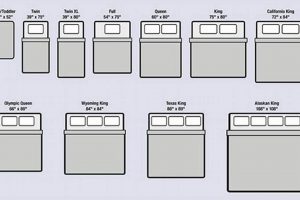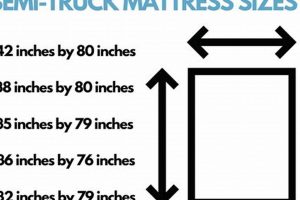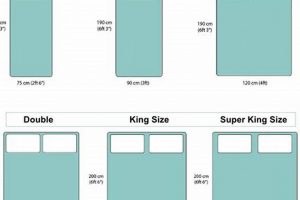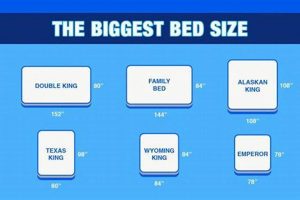A non-standard mattress dimension exists, commonly referred to as a “three-quarter” size. This mattress measures approximately 48 inches wide and 75 inches long. This dimension fills a gap between a twin and a full-size bed, offering a sleeping surface suitable for a single adult where space is a constraint. For instance, a studio apartment or a guest room might benefit from the space-saving design afforded by this less common mattress size.
The historical usage of this mattress size highlights its pragmatic purpose. Before standardization in mattress manufacturing became widespread, variations in dimensions were more common. A three-quarter size offered an alternative to the narrower twin for increased comfort without consuming the floor space of a larger full-size bed. Its benefit lies in providing a comfortable sleeping area while optimizing the available space within smaller living quarters. It has also historically been used in settings such as boarding schools and summer camps.
The following sections will delve into the practicality of selecting this size, availability considerations, suitable bedding options, and ideal room dimensions to accommodate it. This comprehensive examination will assist in determining if this mattress dimension aligns with specific needs and spatial requirements.
Considerations for Acquiring a Three-Quarter Mattress
Selecting a mattress of a specific, less common size requires careful planning. The following points offer guidance to ensure a satisfactory acquisition.
Tip 1: Measure the Intended Space: Prior to purchase, accurately measure the available floor area where the mattress will be placed. Allow adequate space for movement around the bed, as well as for associated furniture.
Tip 2: Assess Bed Frame Compatibility: Ensure the existing or intended bed frame is specifically designed to accommodate this non-standard mattress dimension. Modifying a standard frame may be required.
Tip 3: Research Bedding Availability: This particular mattress size necessitates specialized bedding. Confirm the availability of appropriately sized sheets, blankets, and mattress protectors from various retailers or consider custom-made options.
Tip 4: Evaluate Individual Sleep Needs: Determine if the dimensions of a three-quarter mattress will comfortably accommodate the sleeper’s height and sleeping style. Restrictive dimensions may negatively impact sleep quality.
Tip 5: Explore Online Retailers: Due to its limited prevalence in brick-and-mortar stores, online retailers often offer a wider selection and potentially more competitive pricing for this less common size.
Tip 6: Confirm Return Policies: As this is a less common item, scrutinize the retailer’s return policy. Ensure the option to return the mattress exists if it does not meet expectations or fit the intended space.
Tip 7: Consider Custom Manufacturing: If specific dimension requirements are paramount, investigate custom mattress manufacturers. While potentially more expensive, this guarantees a precise fit.
By carefully addressing these considerations, individuals can mitigate potential challenges associated with acquiring this size and ensure the selection meets their individual spatial and comfort requirements.
With a comprehensive understanding of the considerations, proceed to the conclusion, which will provide a final summary of the information.
1. Width
The specification of “Width: 48 inches” directly defines a critical dimension of the mattress. This dimension, along with the length, is fundamental in categorizing and distinguishing a mattress of this measurement from other standardized sizes such as twin (typically 38 inches wide) or full (typically 54 inches wide). The 48-inch width determines the amount of lateral space available for a sleeper. A 48-inch width is smaller, but still offer more sleeping space than standard twin mattresses, a dimension that may become a necessity for comfortable sleep.
Consider the practical application of this dimension in space planning. A bedroom with limited square footage might preclude the use of a full-size bed, while a twin bed might feel too constricting for some individuals. In this scenario, a mattress with “Width: 48 inches” can present a suitable compromise. This dimension offers a tangible benefit: optimizing available space without sacrificing too much sleeping area. For example, in older homes or apartments with smaller rooms, the space saved by choosing a 48-inch width can allow for the inclusion of other necessary furniture, such as a desk or dresser, that might not otherwise fit.
In summary, the “Width: 48 inches” is not merely an arbitrary measurement but a defining characteristic that dictates the suitability of this size for specific space constraints and individual comfort preferences. Understanding this dimensional constraint is essential for informed decision-making during the mattress selection process, ensuring the chosen mattress appropriately meets both spatial requirements and individual needs, while the sleeper can be safe and comfortable.
2. Length
The specification of “Length: 75 inches” forms an integral component in defining the overall dimensions of a three-quarter mattress. This measurement, along with the mattress width, determines the total surface area available to the sleeper and significantly influences the selection process.
- Suitability for Average Height Individuals
A length of 75 inches generally accommodates individuals of average height, typically up to 5’10” or 5’11”. This length provides adequate space for comfortable sleep without the sleeper’s feet extending beyond the mattress edge. The prevalence of this dimension reflects a design geared towards accommodating a broad segment of the adult population.
- Space Optimization in Compact Rooms
The 75-inch length, while providing adequate sleeping space, also contributes to space efficiency within smaller rooms. Compared to longer mattress sizes, such as queen or king, the reduced length of the three-quarter helps optimize floor space, allowing for better furniture placement and ease of movement within the room. For example, in guest rooms or studio apartments where space is a premium, this length presents a practical solution.
- Compatibility with Standard Bed Frames
While the three-quarter mattress as a whole is not a standard size, the 75-inch length corresponds to the standard length of a twin or full-size mattress. This dimensional similarity can sometimes facilitate the adaptation of existing bed frames, although the difference in width will necessitate modifications or custom support structures. The shared length dimension simplifies certain aspects of bed frame compatibility, even if complete interchangeability is not possible.
- Impact on Sleep Quality
The 75-inch length’s adequacy is directly related to individual comfort. Individuals significantly taller than 5’11” may find this length restrictive, potentially leading to discomfort and disrupted sleep. Consequently, assessing one’s height relative to this length is crucial when considering the appropriateness of a three-quarter mattress. Individuals who find that their feet often hang off the edge of a 75-inch mattress are likely to benefit from a longer mattress.
In conclusion, the “Length: 75 inches” measurement is a defining characteristic of a three-quarter mattress, influencing its suitability for specific individuals and room configurations. Its optimization for average heights and contribution to space efficiency render it a viable choice in particular circumstances. While potential limitations related to taller individuals exist, the length dimension’s alignment with certain standard bed frame components offers some level of versatility.
3. Smaller than Full
The designation “Smaller than Full” directly relates to a defining attribute of a three-quarter mattress. A full-size mattress, also known as a double, typically measures 54 inches in width and 75 inches in length. A three-quarter mattress, at approximately 48 inches wide and 75 inches long, exhibits a narrower width, thus establishing its position as dimensionally smaller than a standard full-size mattress. This size disparity is critical in understanding the practical applications and limitations of this less common mattress type. The reduced width results in a smaller sleeping surface area, influencing suitability for single sleepers, space optimization in smaller rooms, and bedding compatibility.
The implications of being “Smaller than Full” are multifarious. First, this mattress provides an alternative for individuals who find a twin-size bed too narrow but do not require the full width of a standard full-size mattress. For example, in compact living spaces or guest rooms, the reduced width allows for more efficient furniture arrangement and improved maneuverability within the room. Second, the “Smaller than Full” size necessitates the sourcing of specialized bedding. Standard full-size sheets and blankets will be too large, resulting in a poor fit and potential discomfort. Conversely, twin-size bedding will be too small, leaving portions of the mattress exposed. Therefore, specialized bedding options become an essential consideration for owners of a three-quarter mattress. Finally, this size distinction directly impacts bed frame compatibility. Standard full-size bed frames are designed to accommodate the 54-inch width, making them unsuitable for a three-quarter mattress without modification.
In summary, the characteristic of being “Smaller than Full” defines the specific niche occupied by this mattress type. It influences its suitability for particular sleeping arrangements, necessitates the acquisition of specialized bedding, and imposes constraints on bed frame selection. While this size can provide an optimal space-saving solution for certain individuals and environments, awareness of its dimensional limitations and associated requirements is essential for a satisfactory purchase and usage experience. This distinction is crucial for the informed consumer, as it directly affects both comfort and practical considerations.
4. Larger than Twin
The attribute “Larger than Twin” is a defining characteristic when considering the physical dimensions and practical applications of a three-quarter mattress. A standard twin mattress measures approximately 38 inches wide and 75 inches long. A three-quarter mattress, with dimensions of roughly 48 inches wide and 75 inches long, provides a significantly wider sleeping surface. This additional width offers a substantial increase in comfort and utility, particularly for single sleepers who find the standard twin size constricting. The difference of approximately 10 inches in width represents a tangible enhancement to the sleeping experience, allowing for greater freedom of movement and reduced feelings of confinement. The designation “Larger than Twin” is therefore not simply a matter of semantics but a fundamental aspect of understanding the functional benefits of this mattress size.
The practical significance of being “Larger than Twin” manifests in several scenarios. For instance, individuals who tend to toss and turn during sleep may find the additional width of a three-quarter mattress more accommodating, reducing the likelihood of rolling off the bed. Similarly, sleepers who prefer to share their bed with pets may appreciate the extra space afforded by this size. Furthermore, the designation “Larger than Twin” can impact bedding selection. Standard twin-size sheets will invariably be too small to properly fit a three-quarter mattress, necessitating the purchase of custom-sized or modified bedding. This distinction underscores the importance of recognizing this defining feature during the purchasing process, ensuring compatibility between the mattress and its associated accessories. The dimension has led to its use in the past for single sleepers who wanted just a bit more width, but not the full width of a “Full” sized mattress.
In conclusion, the phrase “Larger than Twin” encapsulates a fundamental characteristic of a three-quarter mattress, directly influencing its suitability for various sleeping preferences and spatial constraints. This dimensional advantage translates into improved comfort, enhanced utility, and specific requirements regarding bedding selection. Understanding this key attribute is essential for making informed decisions and ensuring optimal satisfaction with the chosen mattress. The designation is also the primary reason why it was created and used in homes and dorms.
5. Specialty Bedding Needed
The phrase “Specialty Bedding Needed” is intrinsically linked to the selection of a mattress measuring a three-quarter size. Due to its non-standard dimensions (approximately 48 inches wide and 75 inches long), commercially available bedding sets designed for twin, full, queen, or king mattresses are invariably incompatible. This incompatibility stems from discrepancies in width and/or length, leading to ill-fitting sheets, blankets, and mattress protectors. The direct consequence of these mismatched dimensions includes discomfort, compromised hygiene, and potential damage to the mattress itself. For instance, standard full-size sheets will be excessively large, creating bunching and discomfort, while twin-size sheets will be too small, leaving portions of the mattress exposed and unprotected.
The necessity for specialized bedding introduces both challenges and opportunities. Procuring appropriately sized sheets, blankets, and mattress protectors may require searching niche retailers, exploring online marketplaces, or commissioning custom-made items. This can translate to increased cost and effort compared to acquiring bedding for standard mattress sizes. However, the opportunity lies in the potential for bespoke designs and materials tailored to individual preferences. Some manufacturers specialize in crafting bedding for non-standard sizes, offering a range of options in terms of thread count, fabric type, and aesthetic design. Therefore, while “Specialty Bedding Needed” presents a hurdle, it also opens avenues for personalization and tailored comfort. An example of how someone can make the investment is to look for specialty stores for RV’s or Antique beds, those are a great starting point.
In summary, “Specialty Bedding Needed” is not a peripheral consideration but a defining characteristic of owning a three-quarter mattress. It presents both logistical and financial implications that must be carefully weighed prior to purchase. While sourcing appropriately sized bedding may require additional effort, the potential for customized comfort and design can offset these challenges. Failing to acknowledge this critical factor can result in a suboptimal sleep experience and potential damage to the mattress itself. The importance of appropriate linens can not be over stated when obtaining the correct bed size.
Frequently Asked Questions
The following questions address common inquiries regarding a mattress size, providing factual information for informed decision-making.
Question 1: What specific circumstances warrant consideration of a three-quarter size?
A three-quarter mattress is best suited for individuals requiring more sleeping space than a twin offers, yet lacking the room to accommodate a full-size mattress. Small bedrooms, guest rooms, or studio apartments frequently benefit from the space-saving dimensions.
Question 2: Where can appropriately sized bedding for this mattress be sourced?
Bedding designed for this specific size can often be found at specialty bedding retailers, online marketplaces, or custom bedding manufacturers. Standard twin or full-size bedding will not provide a suitable fit.
Question 3: Does this mattress size offer adequate support for multiple sleepers?
This mattress size is primarily intended for single sleepers. The limited width is generally insufficient to comfortably accommodate two adults.
Question 4: What is the typical lifespan of this mattress, compared to more common sizes?
The lifespan of a mattress is primarily determined by material quality and usage patterns, not solely by its dimensions. Properly maintained, a mattress of this size should exhibit a comparable lifespan to other mattress sizes.
Question 5: Is this mattress size readily available across all retailers?
This mattress size is less prevalent than twin, full, queen, or king sizes. Its availability is typically more limited, necessitating a search of specialty retailers or online vendors.
Question 6: Are bed frames specifically designed for this mattress size commonly available?
Dedicated bed frames may require sourcing from specialty suppliers or modification of standard frames. Prior to mattress purchase, confirmation of compatible frame options is advisable.
Understanding these key points will assist individuals in evaluating the suitability of a mattress for their specific needs and spatial constraints. Considerations range from size to finding the appropriate frame and bedding. These issues can be overcome by working with specialty stores.
what size is a 3 4 mattress
This exposition has detailed the defining characteristics of what size is a 3 4 mattress, underscoring its non-standard dimensions of approximately 48 inches wide and 75 inches long. The analysis encompassed considerations of space optimization, bedding compatibility, and suitability for single sleepers. The information presented emphasizes the importance of carefully evaluating individual needs and spatial limitations prior to acquisition.
The informed selection of a mattress size hinges on a comprehensive understanding of its attributes. As demonstrated, this non-standard dimension presents both advantages and challenges. While offering a space-saving alternative to larger mattresses, it necessitates specialized bedding and potentially limited availability. It now remains incumbent upon the reader to apply this knowledge to their individual circumstances, ensuring a judicious and well-informed decision that aligns with their specific requirements. The information serves as a guide for future mattress shopping.







